Vorke V1 is a Braswell mini PC pre-loaded with Windows 10, powered by an Intel Celeron J3160 quad core with 4GB RAM, 64 GB internal storage, and two important features if you want to use it as a desktop PC: support for internal 2.5″ hard drive, and dual display support via HDMI and VGA ports. GeekBuying sent me a sample for review, and I’ll do a two part review, starting with pictures of the device, and its internal, before publishing the second part testing the performance, stability and features of the mini PC.
Vorke V1 Unboxing
There’s not much to say about the package, as it’s just a bland carton box with a sticker with Vorke V1 name, processor and memory info.
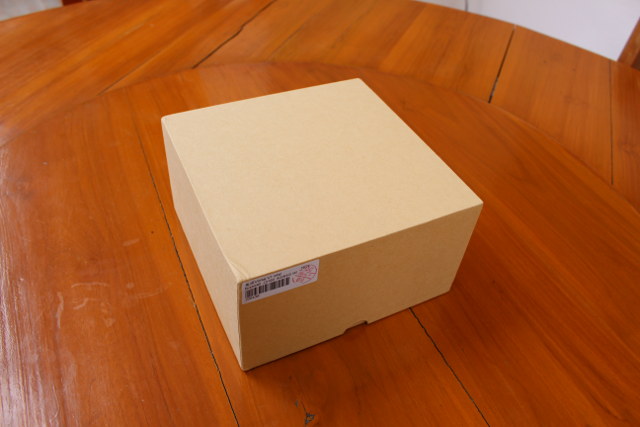
The mini PC ships with a 19V/2.1A power supply and a power cord, as well as a mounting bracket and 5 screws for 2.5″ SATA SSD or HDD.
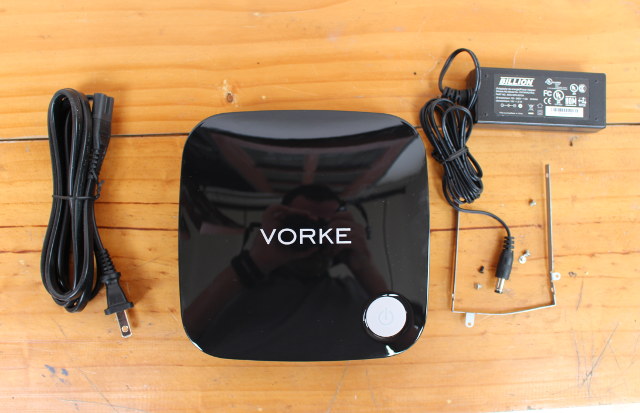
The top cover is quite glossy and features a large power button.
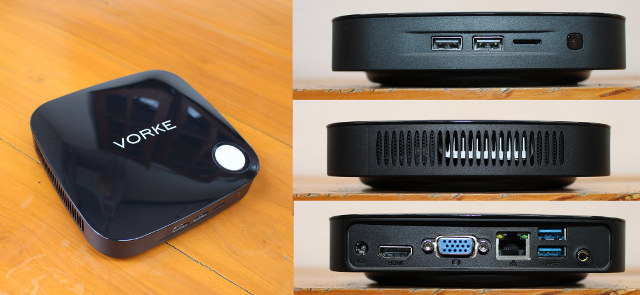
The front panel exposes two USB 2.0 ports, a micro SD slot, and a small window for an infrared receiver, not commonly found on Intel mini PCs. The two side has large ventilation holes, and the rear panel features the power jack, HDMI and VGA output, Gigabit Ethernet, two USB 3.0 ports, and a 3.5mm headphone / Line out jack.
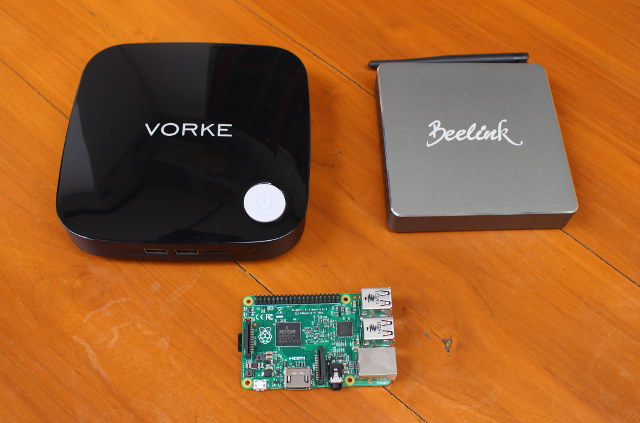 I found Vorke V1 to be larger than most devices I’ve received, so I took a picture with Beelink BT7 and a Raspberry Pi 2 board for comparison.
I found Vorke V1 to be larger than most devices I’ve received, so I took a picture with Beelink BT7 and a Raspberry Pi 2 board for comparison.
Normally I’d go to the teardown part now, but with Vorke V1 I have one more step to do, as I can install a 2.5″ hard drive or SSD.
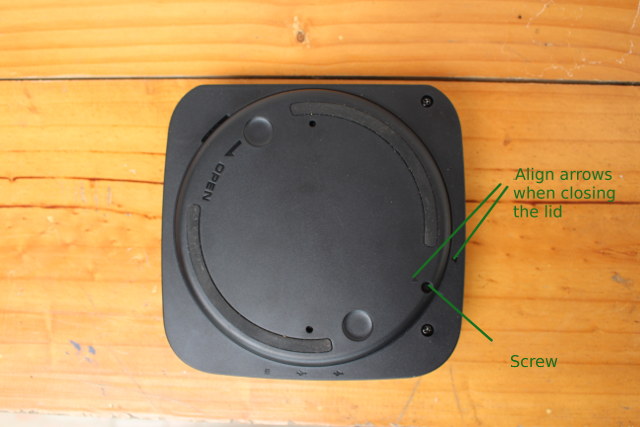 To do so, I had to loosen one screw on the bottom of the case, and turn the lid anti-clockwise to open it.
To do so, I had to loosen one screw on the bottom of the case, and turn the lid anti-clockwise to open it.
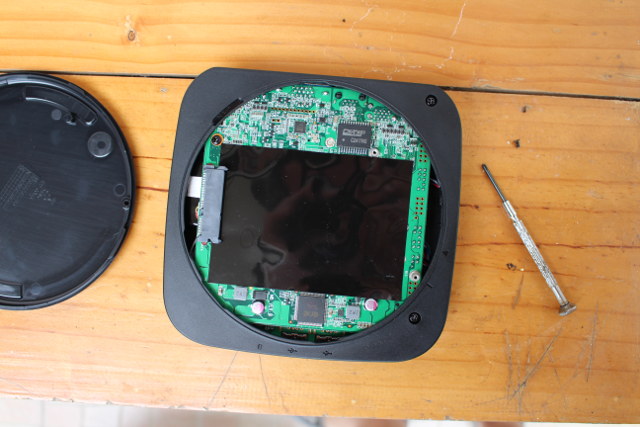
We can see the bottom of the board with a black protection sheet where you are supposed to install the drive. While I’m here, components of interest include CO-TOP C2417NS (probably Gigabit Ethernet magnetics), ITE IT6513FN DisplayPort to VGA controller, and ENE KB9029Q C embedded / keyboard controller with 8051 MCU, 128KB flash.
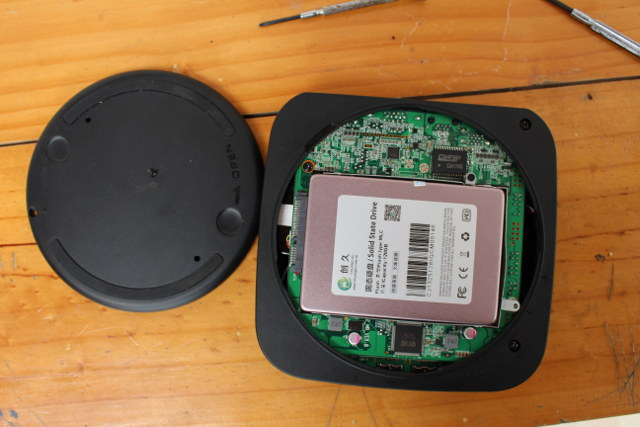
I used a thin 128GB SSD drive first, and the first step is to install the drive inside the mounting bracket with the four screws, before inserting the drive into the SATA interface, and tightening the remaining black screw in the location close to the CO-TOP IC. You can then put back the lid, making sure the two arrows are aligned as shown in the picture of the bottom of the case, before turning it clockwise, and tightening it the screw.
But for the next part of the review, I decided to scavenge a 1TB hard drive from another device, namely a Toshiba MQ01BD100.
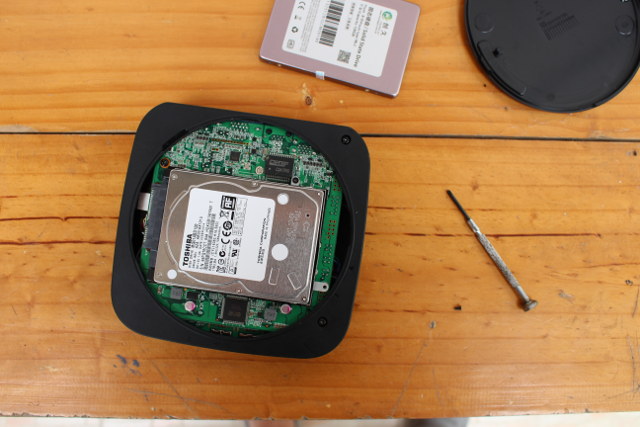
The drive is 9.5mm thick, while the SSD was 7 mm thick, and while I could still close the lid, there was a small gap as shown below. So it might be better to use 7mm drives with Vorke V1.
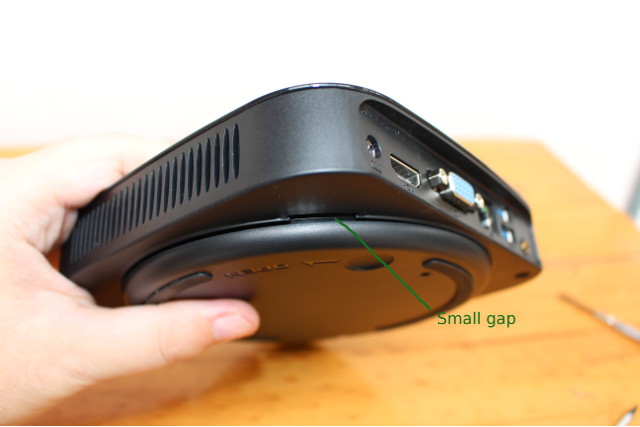 That’s just a minor issue, and it should not affect the performance.
That’s just a minor issue, and it should not affect the performance.
Vorke V1 Teardown
In order to access the top of the main board, you’ll first need to remove the bottom cover, loosen three screws, before popping up the top cover with a sharp plastic tool, and working your way around.
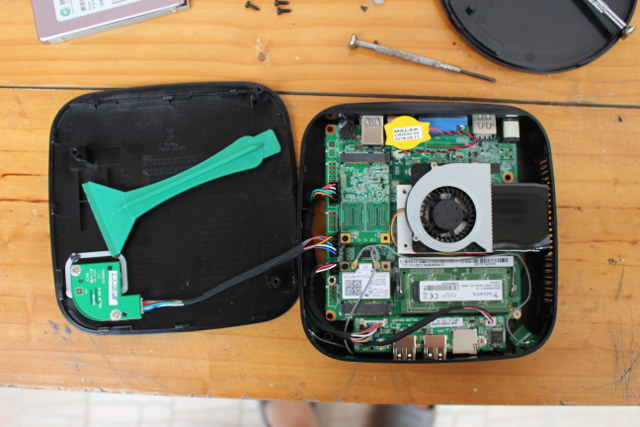 The first thing that came to mind is that this mini PC is modular with removable memory, storage and Wireless module. Let’s check the board in more details.
The first thing that came to mind is that this mini PC is modular with removable memory, storage and Wireless module. Let’s check the board in more details.
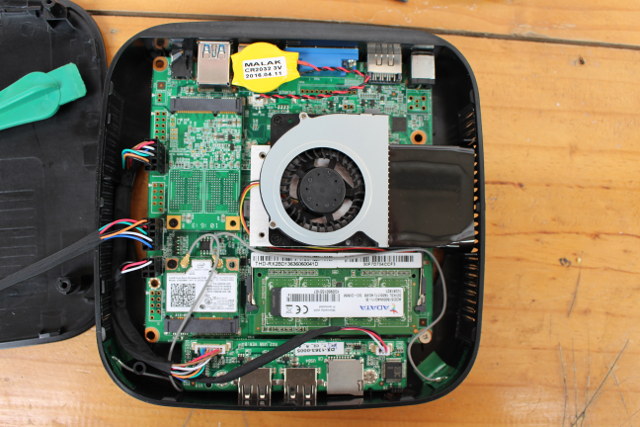
The mainboard takes ADATA ADDS1600W4G11-8 SO-DIMM module with 4GB DDR3L RAM, Intel Dual Band Wireless-AC 3160 module with 802.11 b/g/n/ac WiFi and Bluetooth, and FORESEE FSSSDBABAC-064G mSATA SSD (See pic below). We can also find an RTC battery, Realtek RTL8111GN PCIe Gigabit transceiver, ALC265 audio codec, RT5067A (not sure what it is), and Realtek RTS5159 USB card reader.
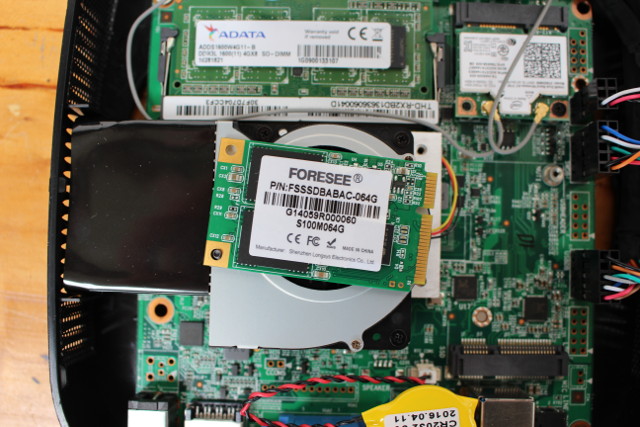 So overall, the system has similar features to an Intel NUC, but a lower price point. The Braswell processor is cooling with a thick metal plate and a fan controller via 3 pins.
So overall, the system has similar features to an Intel NUC, but a lower price point. The Braswell processor is cooling with a thick metal plate and a fan controller via 3 pins.
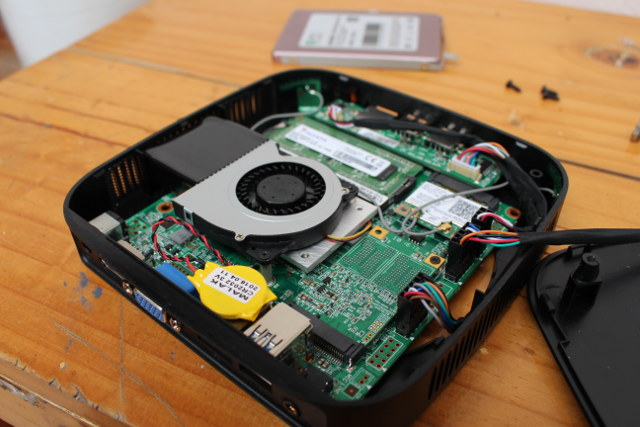
There are also a few unused headers that would allow for some hardware hacking with UART, USB, LPC, and microphone headers.
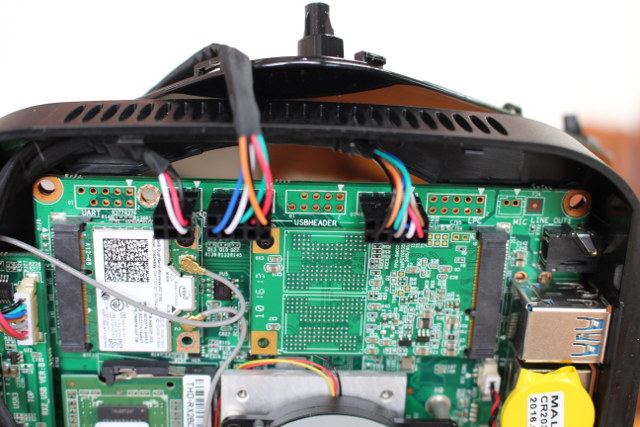
I found the hardware quite interesting to study, and it’s the most module low cost low power mini PC I’ve reviewed so far, with no soldered memory, storage or wireless module. We’ll have to see how well it performs under load, as apart from the fan and “heatsink” on the processor, not much else has been done for cooling. GeekBuying claims Windows 10 Home is activated in the device, and they also quickly and successfully tested Ubuntu 16.04, so I asked them whether they planned to sell a cheaper version without Windows 10 license, but there only answer was people could install the OS they wanted…
I’d like to thank GeekBuying for provide the device, and they sell it for $199.99 including shipping, but you can get that down $159.99 to with coupon VORKEV1. The only other seller I could find is Banggood where it goes for for $199.

Jean-Luc started CNX Software in 2010 as a part-time endeavor, before quitting his job as a software engineering manager, and starting to write daily news, and reviews full time later in 2011.
Support CNX Software! Donate via cryptocurrencies, become a Patron on Patreon, or purchase goods on Amazon or Aliexpress





Windows’s Love affair with Intel is what making them survive , Otherwise Intel is no where near ARM
That’s overpriced. You only get a terribly slow Foresee SSD plus 4GB RAM compared to the barebones.
You can find much better engineered boxes from Intel NUC, Zotac, Gigabyte, ASRock, Shuttle. With more connectivity choices and no Windows tax. Pay only for as much RAM and SSD as you want.
Of course, this whole Intel box category will die out, whenever a low-cost ARM SoC finally gets competitive (m)SATA and standard GbE. Sigh.
@Keith
You must be kidding.
This comes with a decent amount of RAM, enough disk space for windows and quite a few apps and Windows on top.
Ac WiFi, Gigabit ethernet and BT 4, 4 x USb ports, MicroSD card reader too.
To put all that into one of the barebones boxes from the likes of Intel etc, the price to give the same functionality will easily match, if not surpass this kind of price.
This provides an immediate out of the box, ready to go solution with added flexibility to expand.
The other great thing about the intel box is that pretty much everything will work out of the box, plugging pretty much any peripheral in will work because of the availability of drivers for just about all hardware and when it comes to media playback with the likes of Kodi, it will just work first time.
Contrast that to low cost ARM boxes, all of which come not being able to be able to do what the advertising promises.
Poor Kodi support, crappy ROM’s that are only enhanced by independent devs to squeeze as much out of them as possible.
Way too much messing around with Android based ARM boxes that leave so many users with frustration.
I’d rather pay more for something that works straight away and will do so consistently that throw good money after bad on cheap and crappy boxes that never ever match their potential.
As for whenever a low cost ARM solution being competitive, that day may well be a long way off when you look at the same mistakes being made time and time again by these Chinese manufacturers.
A realistic view is required that will enable the Intel boxes to easily survive and prosper for a long time to come.
Unlike Intel boxes, most ARM variations have fixed memory and storage anyway, so you don’t often get the choice to pay for the RAM and storage that you want.
Now that deserves a real sigh.
@PhilS
I agree,
I was searching for a barebone some days ago and didn’t found anything so featurfull for this price. With the well known brands (shuttle, gigabyte, asrock) you will have a barebone for 200€ with no ram, no disk + they ship with older processors, no msata, no ac-wifi. I asked shuttle why no msata on the mini-pcie, the answer was this is a low cost pc and why do you need msata if there is a normal sata port…
By the way, what did intel wrong? Lately everybody is picking on them. As far as I know, it’s the only cpu/soc/gpu vendor with mainline support!
@Keith
You must be kidding #2
If you have a Wintel box, you get OS-updates for 8-10 years or so. For example: Windows Vista was released in 2006 / 2007, and it’s still supported. And on a Wintel-box you’re able to install a Linux version of your choice.
Back to ARM: What you buy is what you get. Rule of thumb: No or very delayed OS updates and security updates. Exception Google hardware (like Nexus) and Motorola.
Unspecced and locked hardware, so hard to put on your own OS.
So I consider ARM throw-away hardware, usable for 0.5 – 2 year or so. And that makes it expensive. More expensive than Wintel hardware.
For all of the above. Please check Giada F210u. Supports all OS that were mentioned above, ie Windows 10 Linux, Android. Has wifi card. And costs less than $150
Nice box, would buy it if it had CEC and HDMI 2.0. Will this one support resolutions of 4K?
Do you know of any Intel box with CEC and or HDMI 2.0?
I fear the usual “no policy for updates” (and thus often: “no updates”) for Android ARM devices is also true for devices running Jide Remix OS (Android & Chinese …). In other words: I expect no updates on a Jide Remix OS device.
So I consider Jide Remix OS devices just toys, and I won’t them.
@Feelgood
I don’t know any low cost Intel solution for HDMI 2.0. Now the cheapest option, I’m aware is to buy a GTX960 GPU… Sadly it did not work well for me on my 4K monitor.
Maybe the new Apollo processors will support HDMI 2.0.
@PhilS, @Sander
– Intel CPU is not main aspect, but modularity YES…
– Systems on ARM CPU have too long support => GNU/Linux
(btw: Vista? Sander you kidding? this is holy crap that nobody normal use…)
– GNU/Linux was on ARM longtime before Android, and is many distribuiton on ARM…
Sure many ARM boards/box have small, but is need say that 1GB RAM+8GB eMMC
is good for Android mediacentrum or lowpower GNU/Linux desktop,
Windows need many more for smooth running and space for install only system+some sw (32GB is minumum)
I think Keith primary ask for choice something as “Vorke V1 Minus”,
with NO included in box and in price:
– NO Windows (for ~-20$ on price, if only choice is reformat to GNU/Linux)
– NO RAM (for own size, vendor and local waranty)
– NO SSD (for own size, vendor and local waranty)
– NO Wifi card (for vendor and local waranty)
Of course not only option, because many people like “endbox”,
with “put cable to socket and power on”, but NOT all people…
@Adam
This is uncomporable:
“4GB RAM replacable in Slot” Vs “2GB RAM fixed OnBoard”
“64GB SSD replacable in Slot” Vs “32GB SSD fixed OnBoard”
“Wifi AC raplaceble in Slot” Vs “Wifi OnBoard”
“2x USB 3” Vs “1x USB 3”
“SATA port with space for 2.5″ SATA” Vs “No SATA port, no space for 2.5”
(ad mSATA in Giada: 1x M-SATA ( only available for higher configuration)
i don’t know what is “higher configuration” and what is price…)
@k3dAR7
“Systems on ARM CPU have too long support => GNU/Linux”
If so, can you give a list of ARM devices on which I can put a mainline Linux and/or Ubuntu Linux? So without hacking and praying?
“(btw: Vista? Sander you kidding? this is holy crap that nobody normal use…)”. No, I’m not kidding. The opposite. And you’re proving my point: Microsoft is NOT saying “well, maybe we stop supporting this 10 year old Windows Vista, because, well, less people use it”. Nope. Microsoft still supports.
Wintel have defined an open standard on which you can put pure Windows and Ubuntu / SuSE/ Fedora Linux stragith from CD / iso-file. And Microsoft keeps updating what they have issues the past 10 years, no matter if your Windows is running on a HP, a Dell or a no-name whtiebox.
There is no such standard nor ecosystem for ARM.
Really? Go back 10 years and what was the main Arm soc?
Go back 10 years and what was the main Windows hardware AMD / INTEL.
Either way a £30 Android box is quieter and cheap on electric to run. PC sales are dying!
So what kind of IR remote are you supposed to use with this?
@Sander, you are saying all right, but to whom? it’s just zealots only capable of calling Vista a “crap” (btw it’s very good Windows, and I suspect it has now more installations worldwide than all linux distributives on desktop xD) and saying “PC sales are dying” and “arm rulezzz and beats intel and wintel”. these are so stupid so absurd noise, that your correct and meanignful arguments look like talking to emptiness would have more sense and wouldn’t be such a wasting time like argue with zealots.
@X.
It should work with any 38 KHz IR remote control, which must be the vast majority on the market. You’d probably have to capture the code, and map the buttons in some keyboard layout file, for example for Kodi.
For that price it must be taken only on Geekbuying. Great Article!
1.For the ninth image,that is not the small gap.It just a slot in order to open the chassis,users can easily go removable hard disk.This is a very user-friendly design.
2.For the thirteenth image, Vorke v1 tv box set aside a number of interfaces, in order to facilitate the expansion. The box can be used in many industries, such as advertising machine, thin client, etc.
3.For the fourteenth image ,It’s not in direct contact with the heat sink and CPU, otherwise it will damage the CPU, the CPU and heat sink are separated by a soft thermal plastic. Both thermal conductivity, but also shockproof
@Sunny
1. That gap does not exist when you don’t use any drive, or use a 7mm drive. It’s an issue with 9.5 mm drives.
been trying to take top off for three days. have 4 different plastic prying tools. two corners will not let go. any help?
@Rustin
Now looking at the picture, you may have to loosen two or three screws on the bottom before taking out the top cover.
bless you, i just didn’t see that. thank you so much.
for anyone else interested: one little black screw unlocks back. unscrew, twist back cover and remove. once inside, 3 slightly larger screws releases top. remove them, turn over and lid will come off easily.
@Rustin
Sorry for the confusion. I’ve edited my post to make it clearer in case other people want to open it.
Maybe a stupid question but if i mount this behind the tv, would the tv remote work? Also, is there a free ram slot for dual channel? Thanks!! 🙂
@Ale
The TV remote will still work. The mini PC does not use remote at all. You might be able to control it with your TV remote through HDMI CEC however, but in any case it won’t be an issue to put it behind the TV.
As you can see from the photos there’s only one RAM slot.
Is the infrared port active on this thing? I just ordered one, and they said there is no remote for it and the commands may not be standard for the remote they are working on. Then read here that it has a “window” for infrared so wasn’t sure if it was a placeholder or had it. Also never see in anyone’s device manager the infrared port showing in the list. Trying to find out the make of this infrared port so I can research power on and off commands for my universal remote while in KODI.
Thanks.
JR
@John
I have not tested it. I can see an IR section on the PCB, and there seems to be something there. It’s not clear enough to know whether is a header for an IR receiver, and the receiver is already installed.
If Vorke cannot provide the drivers for it, it may not work at all. Maybe WinLIRC would be a way to test if you can commands from your remote control.